Why is there a lot of foam in the dishwasher?
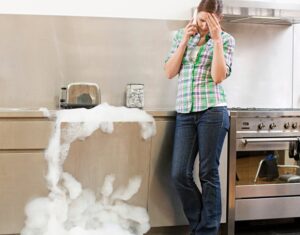 When everything is fine, then after the end of the program there should be only clean dishes in the working chamber of the dishwasher. Sometimes, when opening the door of the appliance, housewives notice a large amount of foam inside. This discovery does not please users, because the cutlery has to be washed.
When everything is fine, then after the end of the program there should be only clean dishes in the working chamber of the dishwasher. Sometimes, when opening the door of the appliance, housewives notice a large amount of foam inside. This discovery does not please users, because the cutlery has to be washed.
Why does a lot of foam form in the dishwasher? What to do if you find a “soap cap” inside? What to do to prevent a relapse? Let's look into the nuances.
Initial actions
What should the housewife do if, while the device is still operating, foam begins to seep out from under the dishwasher door? Under no circumstances should you let the situation take its course. If you notice a problem, you must:
- stop the wash cycle;
- turn off the machine using the button and unplug the power cord from the network;
- open the door;
- remove cutlery from the hopper;
- scoop out the water and foam from the machine;
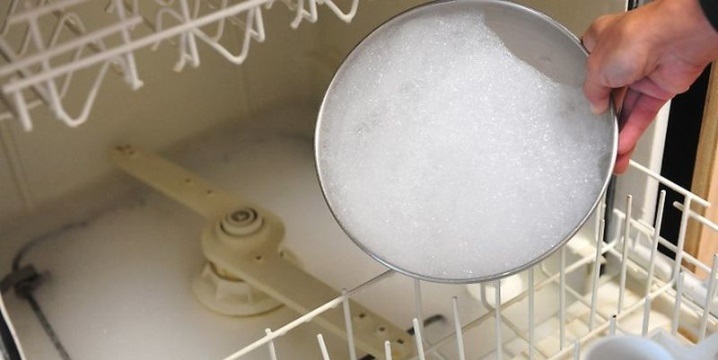
- wash the walls of the chamber with a clean wet cloth;
- Wipe the hopper dry from the inside.
Most likely, after such treatment, some soapy liquid will remain in the machine, since it is very difficult to completely remove it from the base and from the hoses. Therefore, after wiping the walls dry, pour half a glass of table vinegar into the dishwasher, directly to the bottom of the working chamber, and add 3 tablespoons of salt.
Then run the shortest wash cycle. Observe the operation of the machine and check whether foaming continues or not. If there are a lot of bubbles, restart the device. Processing continues until the dishwasher is completely clean.
Obvious reasons for the appearance of foam
In a normal situation, the dishwasher should be clean after completing the program.However, users occasionally encounter excessive foaming. A large amount of foam most often indicates a violation of the equipment operating rules, and not a malfunction.
Often increased foaming is caused by a clogged garbage filter.
One of the basic rules for using a dishwasher is to clean the dishes from food residues before loading them into the working chamber. If you put plates with a layer of fat into the unit, then someday the “trash can” mesh will become clogged. Water will have difficulty seeping through the holes, and the detergent will linger inside until the wash is completed.
What else can lead to increased foaming?
- Wash mode settings are incorrect. Capsules, tablets, and powders can be loaded into a standard dishwasher. Their structure is different, some dissolve in water faster, some more slowly. Therefore, when choosing a program, you need to focus on the form of the detergent used.

- Residues of food found on cutlery. Before loading the devices into the machine, they should be cleaned with a sponge or damp cloth. Certain products, for example, eggs, milk, kefir, pieces of dough, foam abundantly when in contact with water.
- Poor quality cleaning compounds. Experts do not recommend buying too cheap dishwasher detergents. Also, do not fill the cuvette with gel designed for manual washing. All this can cause excessive foaming.
The foam will “climb” even during the rinsing stage, if the product dissolves unevenly. For example, a compressed tablet needs more time to “accelerate” than granules.And if you do not adjust the mode settings, the capsule will dissolve throughout the entire cycle, until the end of the program.
We eliminate problems that provoke the appearance of foam
In the vast majority of cases, foam in the hopper is not a sign of any serious damage. Any housewife can solve such a problem. What to do will depend on the specific situation. We will analyze each possible cause and tell you how to eliminate it.
When a clogged filter becomes the cause of increased foaming, the following actions must be taken:
- turn off the power to the dishwasher;
- open the working chamber door;
- remove the dish baskets from the hopper;
- unscrew the filter element along with the mesh behind it;
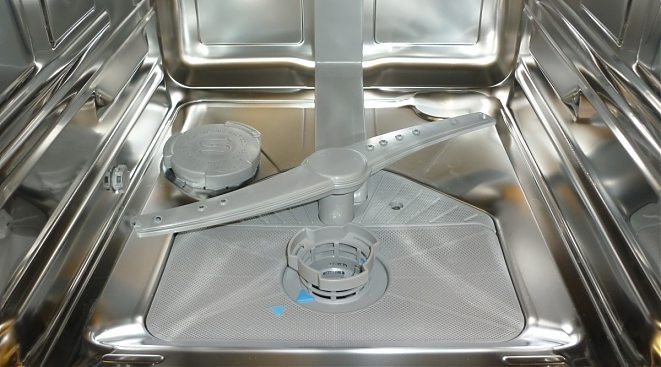
- rinse the filter and mesh under high pressure water, remove dirt with a brush or sponge;
- install the elements in their original place.
Fat, small debris, and pieces of food settle in the filter. If you do not remove food residues from the dishes before loading them into the dishwasher, the mesh will clog very quickly. It will be difficult for the circulation pump to pump water, as it will hardly seep through the holes. Therefore, the foam will remain in the hopper even during the rinsing phase.
For preventive purposes, it is recommended to clean the dishwasher filter at least once every 2 months.
If you recently changed your detergent, switching from powder to capsules, then this may be the problem. Sometimes the program takes less time than the tablet needs to completely dissolve. To correct the situation, you will need to adjust the cycle settings through the dashboard.
On most dishwashers, you can change the wash and rinse times manually.Try setting a longer mode and watch the machine work. After adjusting the settings, the problem should be resolved.
Some dishwashers can automatically recognize which product has been loaded and adjust the program settings themselves. On some models, the user can specify what is used for washing, powder or tablets. Based on this, the device starts the appropriate cycle.
Sometimes the cause of increased foaming is food with a high protein content: cottage cheese, eggs, dough, etc. To prevent this, it is important to first remove any remaining food from the dishes. To fix the problem, you will have to manually clean the working chamber of the machine.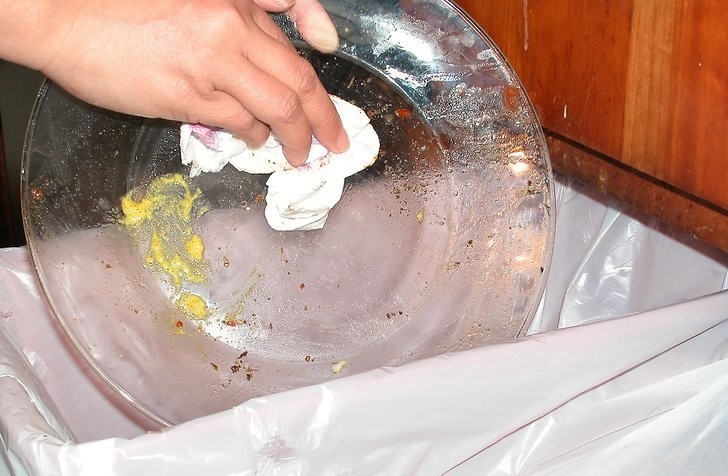
A lot of foam appears in the dishwasher due to the use of low-quality or unsuitable detergent compositions. For example, if a special powder or capsule runs out, users can easily pour a regular gel like Fairy into the cuvette. Then foam begins to form in large quantities.
To fix the problem, you will have to wash the inside of the machine. Use a damp cloth to wipe the walls and base of the working chamber. Also be sure to rinse the detergent compartment. After this, the “idle” cycle starts. If there is still a lot of foam, the procedure should be repeated.
Interesting:
Reader comments
- Share your opinion - leave a comment
Categories
Washing machine repair


For buyers

For users

Dishwasher

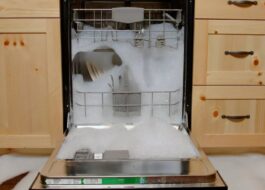

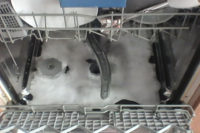













Add a comment